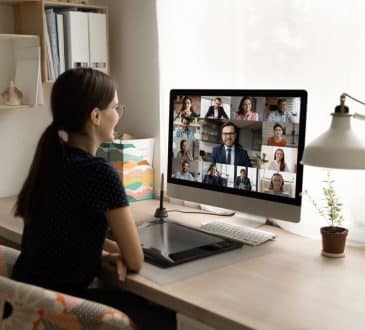Are CEOs creating a digital well-being crisis at work?

Do you struggle to find thinking and feel the pressure to be “always on”? Do you lack visibility over hybrid and remote workers and worry about how this affects the company culture? Are your employees constantly stressed, not coping with the pace of work, and struggling to produce innovative ideas? These challenges have the same root – your organization’s lack of a digital wellbeing culture. As a senior leader, you might unknowingly create a digital well-being crisis.
Are you showing a poor personal example?
Meet Anne*, a C-level leader who constantly checks emails, responds to messages, and engages in work-related tasks outside normal working hours, including weekends and vacations. She hardly finds the mental capacity to speak to direct reports and complains that she has no brain space and time to think. Especially since working from home has become the norm. Anne feels she is not “allowed” to turn off, even if she allows her people to do it.
The real problem of leaders like Anne is not the lack of time, but rather scattering their attentional resources and not taking time to recover them. Human brains are cyclical. To function properly, they need proper breaks. Research shows that an overloaded brain cannot come up with an innovative solution and retreats to the most ordinary one. The abundance of choices (even such small ones as whether to read an email) leads to worsened decision-making and making less satisfactory choices.
Anne’s blurring of the boundaries between work and life not only leads to her feeling stressed, damages her ability to think clearly, and in the long run, to worse decisions and decreased creativity. It also sends a wrong signal to the employees that “always on” is encouraged, leading to a culture of burnout and reduced work-life balance. Even if Anne added a signature to her email saying that she doesn’t expect the person to answer outside of the working hours, her own behavior still would still send wrong signals due to her seniority. Not to mention other more extreme cases, when a senior boss texts an employee at 10pm over WhatsApp for “just a quick question”. Very few people would have the courage to push back on it.
Leaders like Anne and their teams would benefit from establishing clear time, space and emotional boundaries between work and life, and prioritizing recovery as a mandatory part of the productivity cycle. Her recovery would start with scheduling regular breaks for attention recovery and stress reduction throughout the day, week, and year. Instead of doing back-to-back meetings (which increase stress levels), it’s recommended to schedule at least a 15-minute break between them. If Anne prefers to work over the weekend, she could use delayed email function, so her messages can go out first thing on a Monday morning, letting employees have rest. She can take some time throughout the year to fully unplug, following the example of Bill Gates who goes on two “thinking weeks” per year into a remote hut in the forest, with no computer/cellphone and a bunch of books.
Are you rewarding busyness and presenteeism?
When Marissa Mayer became the CEO of Yahoo, she discovered that many employees didn’t log into the company system when working remotely and concluded that they weren’t working at all. Based on this, she asked everyone to return to the office full-time. While her conclusion that being logged in = working might have been true for some individuals, Mayer sent a wrong signal to the staff that busyness = productivity and that from now on they would be rewarded based on being “present”, not on the outcomes of their work. Unsurprisingly, the company lost its best people.
Mayer’s behavior is not uncommon. Often employees who get promoted are those creating the most noise – being at all meetings, sending the most emails or being the first ones to reply to them. These people are not necessarily the best performers. Another side of it is an obsession with superficial productivity metrics, like number of emails sent (like used in the Microsoft Productivity Score metrics). This produces the opposite effect - knowledge workers who feel tracked are 94% more likely to sometimes pretend to be working due to the pressure to be “always on.”
Measure and reward people based on the outcomes, not on how much digital noise they are creating or how many hours they are logged into a particular system, otherwise this sends a wrong message to your best performers. For global teams that need to be “always on”, implement a system where responsibility for managing global communication is rotated among team members. This ensures that no single individual feels burdened by the need to be constantly available.
It’s important however that unplugging doesn’t become “one more thing” to do on the employee’s agenda, and can be exercised flexibly rather than them being assessed based on it. Otherwise it can lead to even more stress.
Are you encouraging distractions?
Company X is a fast-growing start-up with employees in several locations. The company founder insisted that employees have the company chat open all the time so that collaboration flows without interruption. When an employee didn’t immediately answer a message in the chat, the founder considered it a sign of “slacking” and made a public point about it. He found it stressful not to see what everyone was doing, as part of the team is remote, and it’s his way to ensure morale is high. This micromanaging behavior led to the opposite outcome, adding unnecessary stress to the employees who were already working hard.
While regular and clear communication is important, it has a huge downside – distractions. Employees in the hybrid world are 2.54 times more likely to experience digital distractions than employees in the on-site world due to more information flows they have to deal with. As a result, workforce distraction cost organizations 14-to-15 times more than health-related absenteeism.
When a person is expected to immediately reply to messages, be available for endless queries, and jump between calls, they cannot be in the state of deep focus. The human brain is not designed to multitask (only 2.5% of people can do that) and this rapid task switching comes with a cost of stress, loss of focus, clarity, decision making, etc. On average, a knowledge worker gets distracted between every 42 to 50 seconds.
The culture of distractions gets widely spread also via using communication tools, like Facebook Workplace or Slack. It is therefore important to help employees set up boundaries around usage of such tools and encourage respect towards one’s own attention and that of other employees. A BCG/Harvard study suggests that predictable unplugged hours, when consultants weren’t available to answer queries and didn’t check emails, increased performance and improved relationships.
Company-wide measures to support the culture of “deep work” could include encouraging time blocking and checking emails at particular times of the day, creating physical spaces in the office with no distractions i.e. silent rooms, and having times/days when no meetings can be booked. A ban on meetings after lunch on Friday would be helpful, so that there was no way the work could extend into the weekend.
Making “deep work” one of the success indicators (KPIs) both for managers and employees would also encourage focus culture. Assess employees based on their ability to produce high-quality work, meet deadlines, and manage their time effectively while minimizing distractions. Be careful with implementing tech-based solutions helping with focus, as they don’t work for all types of personalities. It’s much more advisable to train employees on how attention works and the benefits of focused state, and provide them with tools to help find and sustain their own attentional rhythms.
It’s also essential that as a leader you work on your own working patterns. If your ideas and priorities keep changing, you will end up keeping your people available for immediate response, even if you verbally encourage them to disconnect. Creating the culture of deep work requires the leader to be very clear about what is expected of employees and when, instead of creating the constant sense of “urgency”.
Are you clear about what’s urgent and important?
Another reason why leaders engage into this controlling behavior we discussed above is when they aren’t clear with their own priorities and their own working patterns are erratic and unpredictable. They want people to be available for immediate response, as their ideas and priorities keep changing. This undermines both their own digital wellbeing, as well as the ability of their teams to feel empowered to switch off and disconnect. This is well reflected in the extraordinary high levels of burnout rates in top tech companies (research) who often use the word “agile” to mask their inability to set clear expectations and schedules for delivery. I’ve seen this a lot, especially in marketing teams working in tech organizations.
Creating the culture of deep work means that the leader needs to be very clear about what is expected of employees and when, and consistently communicate these priorities. In the world full of information and distractions, where everything is fighting for people’s attention, you cannot keep people constantly in the sense of “urgency” and that you need to set up priorities very clearly, is crucial to create the culture of digital wellbeing.
Are you prioritizing relationships, or technology?
A C-level executive in a pharmaceutical company loves the new technology and is constantly seen with the latest tech gadgets, whether it’s smartphones, tablets, smartwatches, or other digital devices, often using them in meetings and other professional settings. People around him get annoyed, as the executive’s attention is divided between devices and “human” discussions and detracts from meaningful interaction during meetings. His behavior signals to others that being constantly connected is a priority, setting unrealistic expectations for employees around the leader and signaling to people around him that they are not important. Research shows that when we speak to others and our phones are visible, even not when ringing, our conversation partner perceives the conversation as less intimate, and us as less interested in them.
If this executive wants to encourage trust in the company, it is highly recommended that they leave all devices outside and being present with those who are in the room 100%. For example, Amazon senior leaders leave all gadgets outside during meetings and take the first 15 minutes of the meeting to read a paper report. A friend of mine chooses to give personal calls to employees and clients over the phone if they are in remote setting once in a while just to ask how they are doing and build trust.
Another typical mistake of implementing new technologies in the workplace is overlooking their acceptance rates. Whether you are giving the full responsibility to CTO over the success of a digital transformation project instead of involving HR and Operations functions, or just making technology a separate function that interacts little with the rest of the company, this creates resistance. According to McKinsey, one third of employees do not know which leader is responsible for most digital/technology functions in the company. Only the collective effort would bring results.
Understanding digital wellbeing is not optional for today’s leader, it’s a pivotal skill to ensure you and your company are ready for the future of work. Ability to keep focus, stress management, good decision-making skills, clearly knowing what’s urgent and important, and strong human relationships is what will make you competitive in the AI age. Recalibrating pace of work to align with human rhythms, not technological ones, starts with your becoming a digital wellbeing champion for your organization.
Written by Dr. Anastasia Dedyukhina.
Have you read?
The Evolving Landscape of the C-Suite: Navigating Complexity with Precision.
Petr Aven: Harmonizing Economics, Philanthropy, and Art.
Your Pizza Perspective: 6 Things African and Western Leaders Can Learn From Each Other.
Recovering from Grief with Dr. Lenore Matthew, a Young Widow and Intuitive Academic.
Can Mindfulness Transform Your Life? Keri Port Says Yes.
Add CEOWORLD magazine to your Google News feed.
Follow CEOWORLD magazine headlines on: Google News, LinkedIn, Twitter, and Facebook.
This report/news/ranking/statistics has been prepared only for general guidance on matters of interest and does not constitute professional advice. You should not act upon the information contained in this publication without obtaining specific professional advice. No representation or warranty (express or implied) is given as to the accuracy or completeness of the information contained in this publication, and, to the extent permitted by law, CEOWORLD magazine does not accept or assume any liability, responsibility or duty of care for any consequences of you or anyone else acting, or refraining to act, in reliance on the information contained in this publication or for any decision based on it.
Copyright 2024 The CEOWORLD magazine. All rights reserved. This material (and any extract from it) must not be copied, redistributed or placed on any website, without CEOWORLD magazine' prior written consent. For media queries, please contact: info@ceoworld.biz
SUBSCRIBE NEWSLETTER








